Have you found some weeds with purple flowers?
Different types of weeds respond best to different methods of eradication and prevention. So it’s important to find out exactly what species you’re dealing with.
In this guide, I’ll help you identify the weed using photos and detailed descriptions.
Let’s dive in.
Henbit (Lamium amplexicaule)
Henbit is an edible weed that takes its name from its popularity with chickens. It’s also one of the most well-known purple flowering weeds.
It’s not unusual to find it growing around buildings, fallow areas, fields, or around your yard. If you’ve found a weed with purple flowers infesting your healthy lawn, then it probably isn’t henbit. But if your lawn is thin and weak, then it has a chance to take hold.
Here are some things to look out for to distinguish it from other weeds:
If you look closely, you’ll see the green stems have a square shape. And they can become purple as they age. With occasional rooting at the lower nodes.
The leaves come in opposite pairs and are heart-shaped or rounded, with deep lobes. And the edges have distinctive rounded teeth. On the upper leaf surface, the veins are depressed, which creates a wrinkled appearance.
If it’s henbit, you’ll notice the leaves further up the plant are attached to the upper stem. Whereas the leaves lower down grow on stalks.
It spreads through seeds. So the key to controlling it is early identification.
Seed dispersal occurs after it flowers in late spring. So using a herbicide in early spring to kill the plant is the best way to prevent seed production.
If the plant is already flowering, then it’s too late. The herbicide probably won’t be effective in preventing seed dispersal.
If you find the plant while it’s still growing, then another method you can use is to pull it out by hand. Making sure to carefully dispose of all parts to prevent regrowth.
If the seeds have already dispersed around your yard, then you can use a pre-emergent herbicide in the early fall to prevent germination.
Creeping Charlie (Glechoma hederacea)
A common nuisance in gardens, if you’ve got a purple-flowered weed taking over your lawn then there’s a good chance that this is the culprit.
Also called ground ivy, creeping charlie is a common broadleaf weed that can quickly take over your yard if you leave it.
It grows low to the ground, usually about 1 inch high, and quickly forms a dense mat of leaves and stems as it spreads.
Other distinguishing features that can help you identify it include a square stem and bright green leaves with scalloped edges, either kidney-shaped or round.
Leaves grow in opposite pairs on either side of the stem attached to a node. And you can see the blueish-purple flowers along the stem when it blooms in spring.
It’s important to know that creeping charlie finds it easiest to colonize lawns that aren’t well cared for. So to keep it away it’s a good idea to regularly mow, fertilize, and water your lawn to help it grow thick and strong. Leaving no room for weeds to become established.
It spreads from rhizomes, stems that can root, and seeds. And it can be difficult to get rid of. Because even after you dig it out of the soil, leaving any part of its rhizomes behind allows the plant to regrow.
If you catch small patches of the plant early in the spring, then it can be worth having a go at hand pulling it. But this often takes a number of attempts to completely eradicate the plant.
The easiest way to get rid of this creeping weed with purple flowers is to use a post-emergent weed killer that can tackle broadleaf weeds.
But make sure the product specifies its use for creeping charlie because not all broadleaf weed killers can do the job.
It’s also important to choose a systemic weed killer. These are absorbed by the plant and kill it from the inside including the roots.
And if you’re using it on grass, make sure it’s selective for broadleaf weeds so it won’t cause harm.
Purple Deadnettle (Lamium purpureum)
Purple deadnettle is a weed in the mint family that’s sometimes mistaken for Henbit. But there are differences when you know what to look for.
Like Henbit, it has a square stem. But the heart-shaped leaves have a gentler scalloping at the margins. And unlike henbit, the leaves aren’t attached to the central stem directly.
The leaves are arranged opposite each other. And closer examination reveals a covering of fine hair.
Purple deadnettle usually grows low to the ground. But it can sometimes grow as tall as 8 to 10 inches.
And it prefers growing in moist areas. So it’s commonly found in fallow fields, drainage ditches, and on the edges of woodlands.
But, if you’ve got irrigation in your yard, or you’re near woodlands or a field, then you could find purple deadnettle encroaching onto your lawn.
If you find a small number of plants then it’s not too difficult to pull them out by hand.
For a larger infestation, it’s more effective to use a post-emergent herbicide in the early spring. If you catch it before it blooms then you can prevent it from producing seeds and spreading further.
As the plant gets bigger, herbicides are less likely to control it, but as it’s a winter annual that dies in the summer, applications in late spring aren’t usually necessary.
Purple dead nettle produces thousands of seeds at a time. And if they’ve spread, then it’s a good idea to use a pre-emergent herbicide in the late fall or early winter. This will stop the seeds from germinating.
Wild Violet (Viola sororia)
Some people are happy to have wild violets growing in their yards. The pretty blue-purple blooms make a good addition to a wild garden.
But if it’s growing in your well-cared-for lawn then that’s another matter.
When young, it prefers a moist and shady growing environment. But the mature plants can spread to sunnier locations and quickly take over.
You can identify wild violet before it flowers by looking at the leaves. They are heart-shaped with a pointed tip and rounded teeth at the edge. The flowers have 5 petals and appear from April to June.
Violets can spread by seed and by short, thick rhizomes, similar in size to your little finger.
For chemical control, look for products that contain triclopyr, 2,4-D, dicamba, and MCPP.
You often need multiple applications to control an infestation. Why?
Because although its use in the spring will control the plants already growing, more plants can germinate and grow from dormant rhizomes between April and September. This long emergence window makes it a difficult plant to completely get rid of.
Violet Wood Sorrel (Oxalis violacea)
Sometimes mistaken for clover, violet wood sorrel is an edible perennial weed. It produces many attractive flowers when in bloom. And some gardeners choose to plant it in ornamental gardens and pots.
The plant grows 6-10 inches tall. And features bell-shaped, pink-purple flowers at the end of thin stems, each with 5 petals. The flowers are usually clustered together in groups of 4-19.
The green leaves consist of 3 heart-shaped leaflets. And sometimes you’ll see purplish markings underneath.
The plant blooms from April to July. And then again from September to November.
Wood Sorrel rapidly spreads in dry, open areas due to its seed capsules. Their fragile casing bursts when touched spreading the contents throughout your yard.
It’s particularly likely to invade lawns that are sparse and poorly looked after. But it will sometimes get a foothold in a healthy lawn.
You can get rid of it by hand. But this is best done soon after it starts to grow, as its root system grows deep and becomes difficult to pull out. And you have to make sure you get all of the root or it will grow back.
If you have a larger infestation then it’s best to head straight for the broadleaf weed killer.
Red Clover (Trifolium pratense)
This short-lived perennial easily grows in most soil types. And it can withstand varying conditions including cool temperatures and drought.
It’s often used by farmers as a cover crop because it fixes nitrogen in the soil. And it”s also useful as a forage crop or hay.
It’s easy to identify:
From late spring to early summer it produces distinctive pink-purple flower heads. With each head consisting of numerous small pink-purple flowers. The flower heads are eventually replaced by seed pods
Its hairy stems grow either spreading or erect and form clumps. And the leaves consist of 3 oblong or oval leaflets, positioned alternately on the plant stem. The leaf margins are smooth and have very small hairs that project away from the plant.
If it gets in your yard it can displace desirable plants. Similar to most lawn weeds, thin and under-fertilized lawns are susceptible to being invaded. So a good way to limit its spread is by making sure you have a thick and healthy lawn.
Getting rid of it by hand can be challenging, as it grows a very deep taproot. So instead, clover is best controlled by herbicides such as fluroxypyr, dicamba, and quinclorac, applied in the fall.
Purple Loosestrife (Lythrum salicaria)
Purple loosestrife is a noxious weed that you’ll sometimes find growing around lakeshores, ponds, wetlands, ditches, and wet pastures.
It’s a tall weed with purple flowers that typically grows between 6 and 10 feet. And features 4-6 sided stems with smooth-edged leaves, and many small 5-7 petalled flowers growing in tall spikes.
Of the weeds that grow purple flowers on our list, this one has the potential to be the biggest problem.
Spreading by seed, rhizomes, taproot, and vegetative growth, it’s hard to control when it’s growing in the right conditions. And it can take over a site in a single year if left unchecked. Choking out plant life in the area, destroying sources of food for other wildlife.
Cutting off the flower heads during the flowering season — late June to early September — can help to limit its spread, as each plant produces millions of seeds. Make sure you dispose of the flower heads carefully by bagging them and taking them to a landfill, or by burning them.
You can pull young plants from the ground. And you can dig out older plants. But make sure to remove all the roots and rhizomes. The same disposal rules apply.
For large infestations, glyphosate herbicides can do the job. But be careful using these around aquatic sites. You should get a product that’s suitable for that environment, such as PondMaster.
Deadly Nightshade (Atropa belladonna)
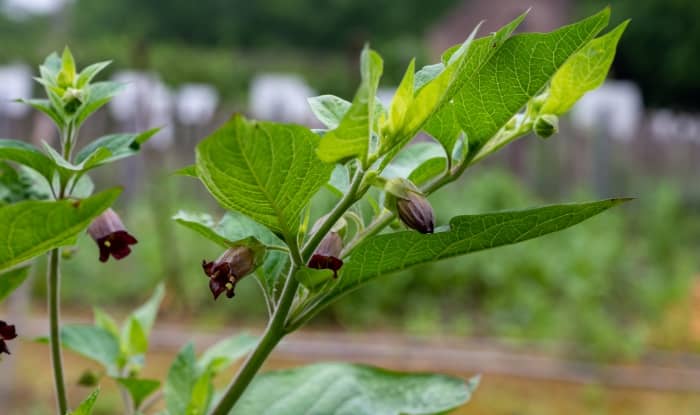
Also known as belladonna, deadly nightshade is notorious for being a highly poisonous weed. All parts of the plant are toxic. Eating its sweet-tasting berries can be fatal, and even just handling deadly nightshade can make you ill from toxins that pass through the skin. If you’re lucky touching the plant will only lead to severe dermatitis.
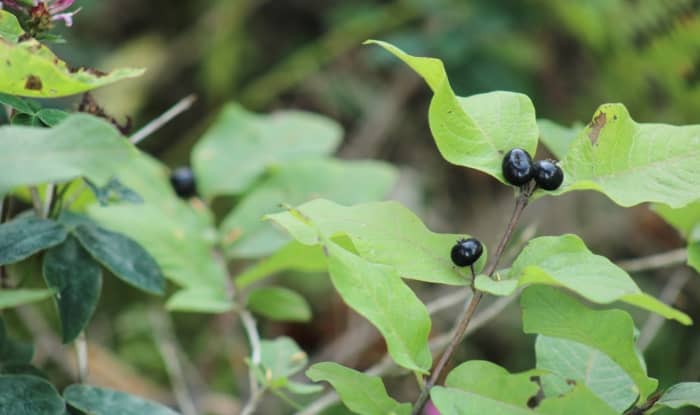
Deadly nightshade is most easily identified by its purple bell-shaped flowers, that bloom from June to September. After flowering, the fruit quickly appears, with green berries at first before turning black and shiny, resembling cherries.
The plant has pale green, oval-shaped leaves that are pointed and ribbed. The leaves have smooth edges and grow alternately from the stem.
Deadly nightshade is often seen in woodlands, scrubland, and growing along paths and banks.
To get rid of deadly nightshade plants growing in your yard, you can dig them out, taking care to remove all the roots, or use a systemic weed killer.
Bittersweet Nightshade (Solanum dulcamara)
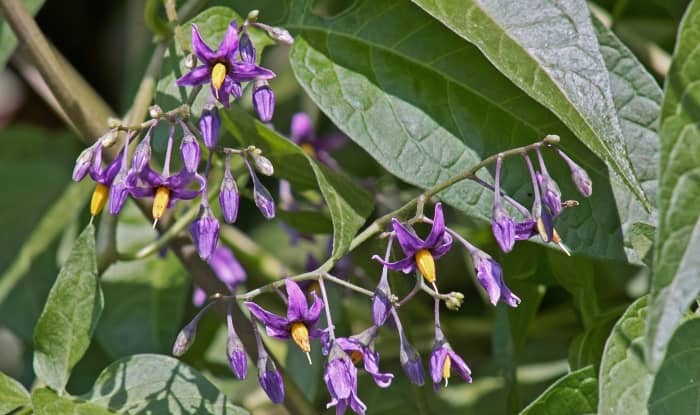
The bittersweet nightshade plant is also known as blue bindweed, bitter nightshade, poison berry, and climbing nightshade. Bittersweet nightshade is a perennial woody vine weed that grows up to 10 ft. in length and climbs when there’s adequate support.
All plant parts are toxic, particularly the clusters of poisonous bright red berries in the fall. Ovate leaves grow alternately on the stiff stems. The leaves are dark green and sometimes purple-tinged and reach between 2-4 inches long. From May to September, small bright purple flowers with eye-catching yellow centers hang in clusters.
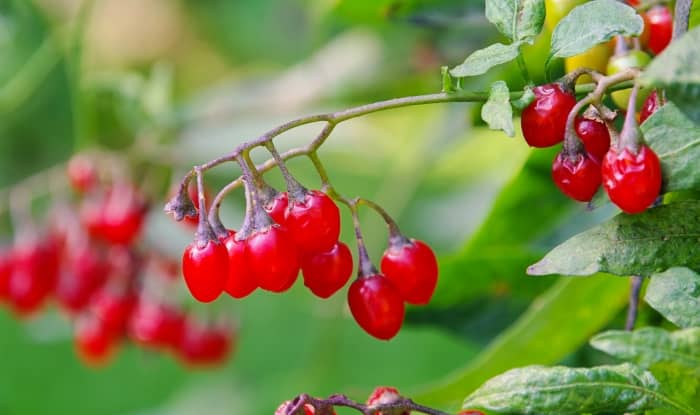
Bittersweet nightshade spreads by seeds and can grow from stem and root fragments. You’ll often find it growing around field edges, gardens, parks, roadsides, and wetlands as the plant likes moist soil.
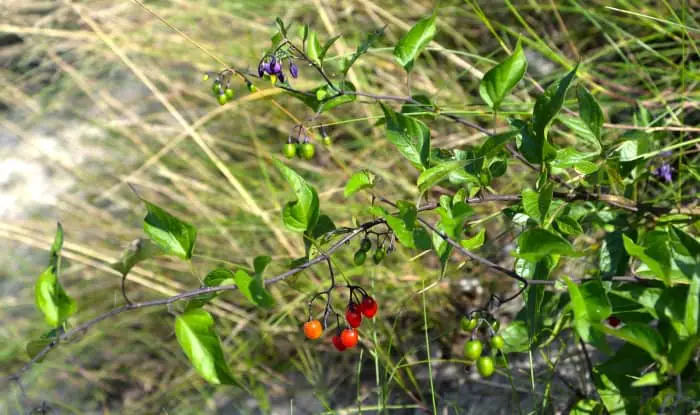
Bittersweet nightshade is toxic. Although not the same plant or as dangerous as deadly nightshade — identifiable by its black berries — it can cause sickness in animals and children that eat its berries, sometimes fatal.
Similar to deadly nightshade, you can dig out bittersweet nightshade or use a systemic herbicide to eradicate the weed.
Common Burdock (Arctium minus)
Also known as lesser burdock, common burdock is a biannual weed. It’s one of the most common weeds with purple flowers to find growing in your yard and on your lawn. You also find it in pastures, paddocks, next to roadsides, and alongside streams.
Identifying burdock is simple. During the first year of growth, the weed develops a basal rosette with large heart-shaped leaves, 6-18 inches long and 4-14 inches wide. The leaves are dark green with fine hairs on the underside. And they have reddish stems that make them resemble rhubarb leaves.
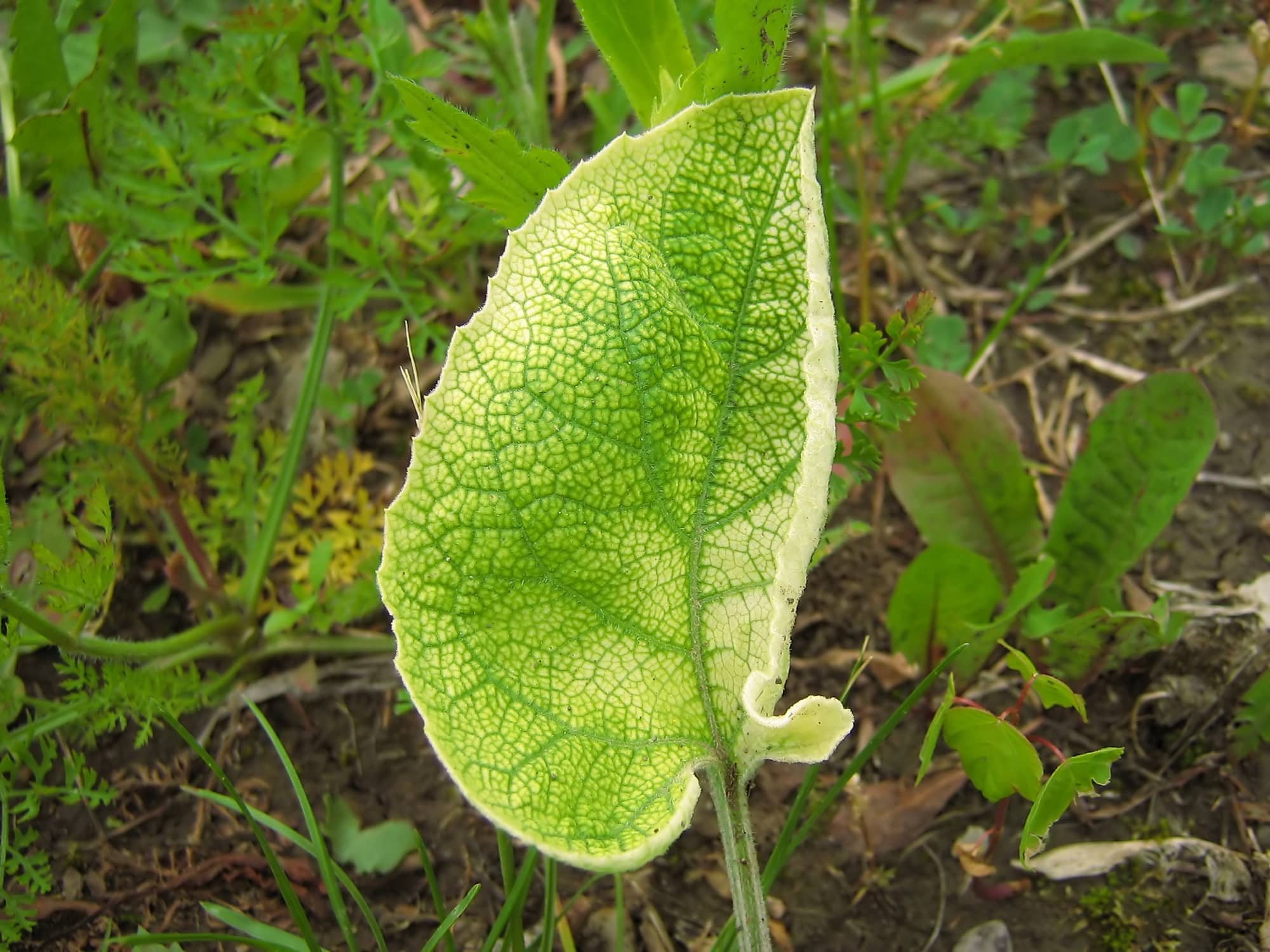
In the second year of growth, burdock sends up a tall hollow stalk that can reach 7 feet high. The weed blooms from July to October, producing lavender to purple flowers at the end of branches and in the leaf axils.
The flower heads resemble a thistle, and are covered in spines. Each flower head dries up as they age. And turn into prickly burrs with curved spines. The burrs easily hook onto clothing or the fur of animals to spread the seed they contain.
Unlike many weeds with purple flowers, common burdock has some uses. The leaves, stalks, and roots are all edible, and you can use them for medicinal purposes.
To control common burdock, cut beneath the soil surface and pull the plant out including a large portion of the taproot.
Dame’s Violet (Hesperis matronalis)
Also called dame’s rocket and damask violet, dame’s violet is a biennial weed, and sometimes a short-lived perennial weed. The plant is originally a native of Asia and Europe. But after introduction as a garden plant, you can now find dame’s violet across many parts of North America where it’s considered an invasive species.
Dame’s violet has bright green leaves that grow up to 5 inches long and 1-½ inches across. The leaves are lance-shaped and taper to a pointed tip. They have toothed edges and both sides are covered in short hairs.
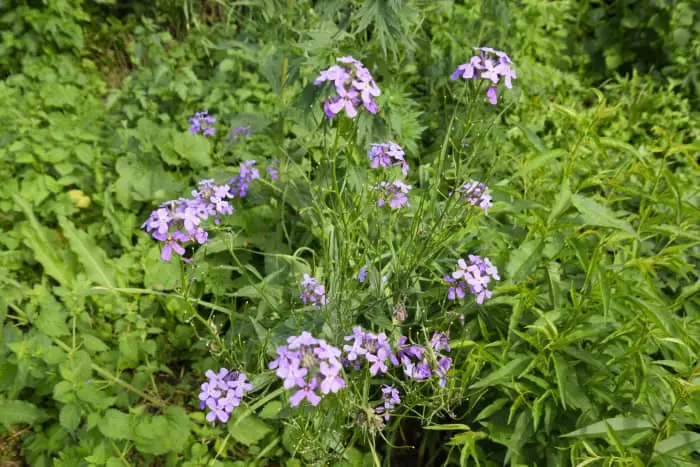
Dame’s violet blooms from May to August, producing flowers that vary from purple and lavender to white. The flowers grow in a panicle at the top of stems that can grow up to 3 ft.
You can control this purple flowering weed by hand pulling, making sure to remove the entire root system.
Hedge Woundwort (Stachys sylvatica)

Hedge woundwort likes growing in woods and hedges. You’ll also find it around waste ground, along the edges of meadows, and in shaded areas of your garden.
Hedge woundwort grows up to 1 meter tall with a square and hairy stem. The weed has large, toothed leaves with a pointed tip. The leaves grow up to 4-inches long, are covered in hairs, and look similar to nettles.
Hedge woundwort is an eye-catching wildflower. At the top of the erect stalk sits a spire of beautiful purple flowers. But it’s also an invasive weed. Hedge woundwort produces a huge quantity of seeds that help it to spread widely. And it also spreads through underground rhizomes.
This plant also has medicinal properties. You can use hedge woundwort as a herbal remedy for stopping bleeding and healing damaged tissue, hence the name.
The roots are shallow and can be easily pulled from the ground. But if you don’t want the plant to regrow you’ll have to make sure you don’t leave any pieces behind. You can also eradicate hedge woundwort by repeated close cutting.
Common Forget Me Not (Myosotis sylvatica)
PURPLE FORGET-ME-NOT FLOWERS BY CATTAN2011
Forget-me-nots are best known for their clusters of small light blue flowers with a bright yellow center, but you can also get forget-me-nots with purple flowers. The flowers are funnel-shaped and have 5 petals and 5 stamens.
Forget-me-not is popular with some gardeners because of its pretty appearance. And it’s often deliberately cultivated. But you have to be very careful. Because the common forget-me-not can easily grow out of control, and make you wish you’d never planted it in your backyard.
In some US states, common forget-me-not is a noxious and invasive weed. It’s a very fast-spreading plant when the conditions are right, thriving in wet gardens and locations with a cool summer climate.
FORGET-ME-NOTS BY WILLIAM WARBY
Forget-me-nots are self-seeding. And the seeds can lie dormant in the soil for up to 30 years before germinating. The weed also spreads by stolons and can be very difficult to eradicate from your garden if you leave it to grow. You can hand-pull forget-me-nots, but they will grow back unless you get rid of every bit of the roots.
Forget-me-not flowers are edible. You can try the small flowers in a salad or as a garnish on your dinner plate.
Creeping Thistle (Cirsium arvense)
Also called Canada thistle, creeping thistle gets its name from its creeping lateral root growth that allows it to quickly spread and form dense clumps
Creeping thistle is an upright herbaceous perennial weed that’s native to Europe, North Africa, and Western Asia. But it’s now found widely around the world in suitable climates.
It was introduced to the US in the 17th century. But 43 states now consider creeping thistle a noxious weed.
The plant grows up to 5 ft. high. And as its root system expands, it sends up vertical shoots and forms vast clonal colonies.
The thick green stalks are smooth and branched. And the dark green leaves have jagged lobed covered in sharp spines. The spiky leaves can grow 20 cm long and 3 cm wide and are larger lower down the plant than on the upper part.
The distinctive flowers are pink-purple and consist of numerous small petals.
Creeping thistle’s aggressive root growth, along with prolific seed production and dispersal, make this a very difficult weed to control.
Bull Thistle (Cirsium vulgare)
Thistles are some of the most easily recognizable weeds. Also known as common thistle and spear thistle, bull thistles have spines that cover the leaves and stems up to the pink-purple flowers. They also have spiny bracts that grow beneath the flower head.
Bull thistles are biennial weeds. In the first year, bull thistles grow a basal rosette of flat leaves with big spikes down the middle. The leaves have jagged edges that are also spiky. In the second year, bull thistles develop a tall stem that can reach 7 ft. in height. Then the giant weed flowers.
You’ll find this prickly weed growing in various conditions and places. But thistles thrive in locations with good sun exposure and rich soil.
You can dig this weed out with a shovel or cut it 1-2 inches below the soil surface before the plant flowers.
Spotted Knapweed (Centaurea stoebe)
Also called star thistle, spotted knapweed is originally a native of Eurasia, accidentally introduced to North America in the 1890s. It’s considered highly invasive and is a problem wherever it grows because it’s poisonous to other plants and creates barren areas where only spotted knapweed can thrive.
It blooms from June to August, producing pink-purple flowers that look similar to thistle flowers. The flowers are small and grow at the end of branched stems. There are bracts around the flower head extending under each flower petal.
When fully mature, it grows up to 4 ft. tall and has long grayish-green leaves with lance-shaped lobes.
You can control spotted knapweed by hand digging or with the use of selective herbicides.
Morning Glory (Ipomoea)
The name morning glory refers to a number of closely related plants, many of which are summer annual broadleaf vines. Morning glory spreads through seeds and regrows yearly but reseeds so successfully that you probably won’t notice.
The plant is well-known for its trumpet-shaped flowers that grow in clusters of 2-5 and come in many colors. You can find morning glory vines with purple flowers, white flowers, pink flowers, blue flowers, red flowers, orange flowers, and sometimes bi-colored flowers. The flowers bloom from June to November.
The heart-shaped leaves grow alternately along the vine. The leaves grow 3-5 inches long and are sometimes glossy.
Morning glory vines rapidly spread in hot weather. A mature plant can quickly grow vines 15 ft. tall, with the stems twisting around each other to strengthen and support the plant’s growth.
Some people like to plant morning glory as a ground cover or aesthetic enhancement for fences and barriers. But because it grows fast, morning glory can quickly become an invasive vine, spreading into yards nearby, growing over all surfaces, and harming plants.
Once established, morning glory can be very hard to get rid of, often requiring the use of powerful chemicals to kill the weed.
Bird Vetch (Vicia cracca)
RAGNAR1904, CC BY-SA 4.0 , VIA WIKIMEDIA COMMONS
Also called cow vetch, boreal vetch, and tufted vetch, bird vetch is a weed with purple flowers native to Europe and Asia, and an introduced species in North America.
Bird vetch is a perennial vine-like weed with climbing stems that reach up to 150 cm long. Pinnately compound leaves grow from the stems consisting of 8-10 pairs of leaflets.
Pretty light purple flowers grow on one side of a raceme, with each cluster containing 10-40 flowers.
HADA,, CC BY-SA 3.0, VIA WIKIMEDIA COMMONS
Bird vetch spreads through seeds and rhizomes. The seeds are large and develop in narrow pods each containing around 5 seeds.
It’s common to see bird vetch growing in disturbed areas such as roadside ditches and old fields.
Another similar-looking weed that also has purple flowers is purple vetch.
Repeated pulling before the seeds mature can help to keep bird vetch in check, but it won’t kill the rhizomes. Systemic herbicides are the most effective way of controlling this weed.
Self-heal (Prunella vulgaris)
Also known as heal-all, carpenter’s herb, and hook-heal, self-heal is a perennial herb widely distributed throughout North America.
Self-heal is a low-growing, creeping weed. Green lanceolate leaves grow opposite from square-shaped stems. The upper surface of the leaves is crinkled. The weed has little purple flowers that grow in spikes at the ends of the stems.
You can get rid of self-heal by repeated hoeing, or digging the plant from the ground with a fork or trowel. The weed spreads by seed, so it’s a good idea to deal with it before June-November when the plant produces them.
You’ll often find this weed growing in turfgrass and lawns, along roadsides, and occasionally in hay fields and pastures.
Self-heal has a long traditional use as a remedy for various ailments.
Dove’s-Foot Crane’s-Bill (Geranium molle)
Dove’s foot crane’s bill is a common weed to find in dry and poorly maintained lawns. It’s an annual weed that’s usually seen from spring to fall.
Dove’s foot crane’s bill grows quickly, sending up hairy reddish stems that reach 14 inches tall. The grey-green leaves are also hairy and are divided into 5-7 rounded lobes.
From April to September, the weed produces pink-purple flowers with notched petals.
If you allow a dove’s foot crane’s bill to flower it can quickly cover your lawn. The plant has seed pods that burst and hurl seeds over a good distance, enabling the weed to spread.
To control dove’s foot crane’s bill you can pull it out of the ground by the roots, it comes out easily in damp soil. Low mowing can also help.

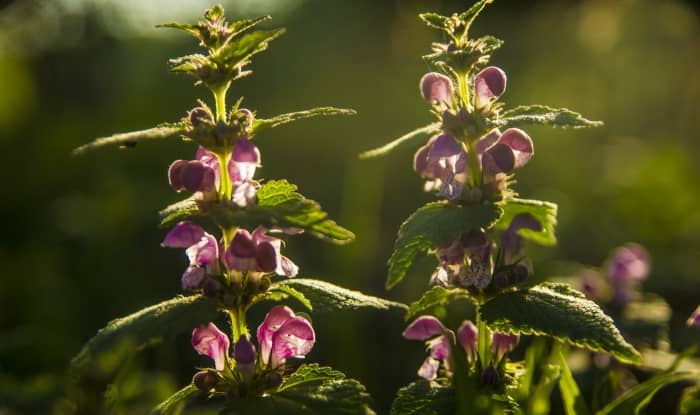
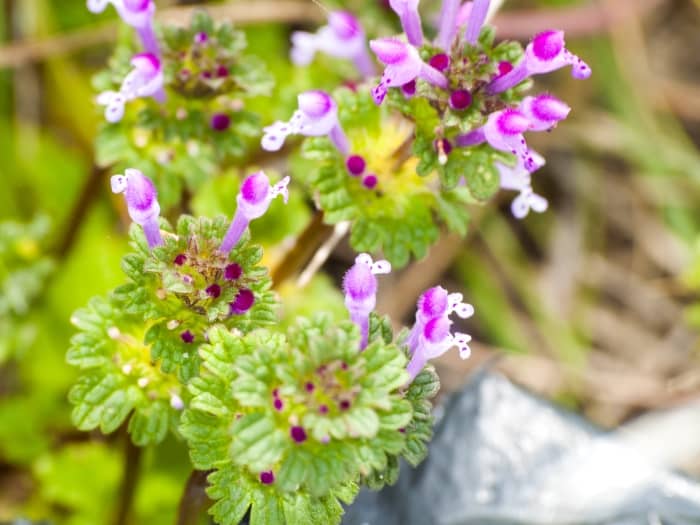
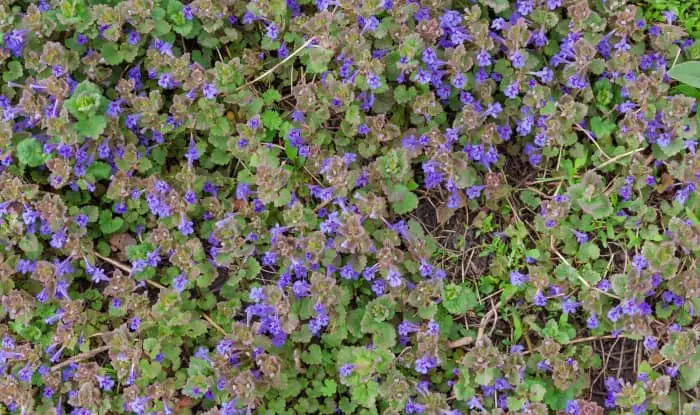

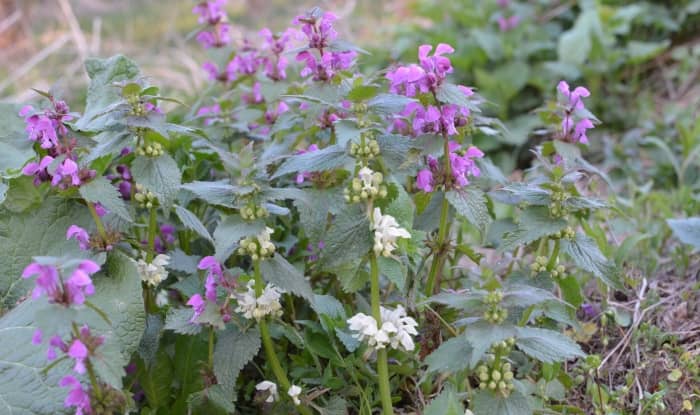

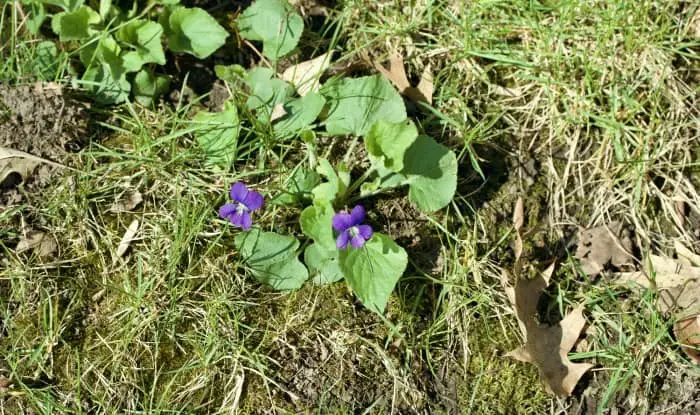

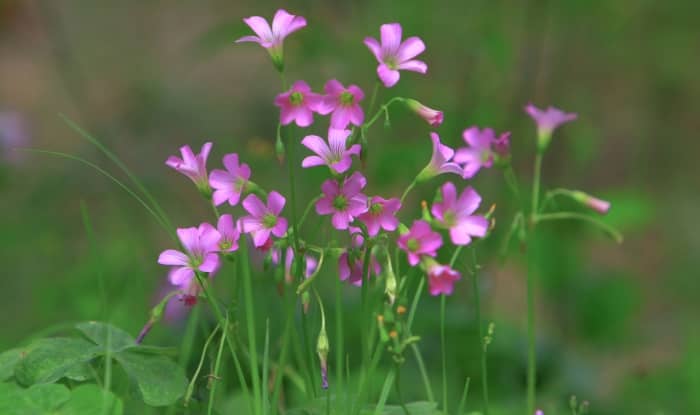
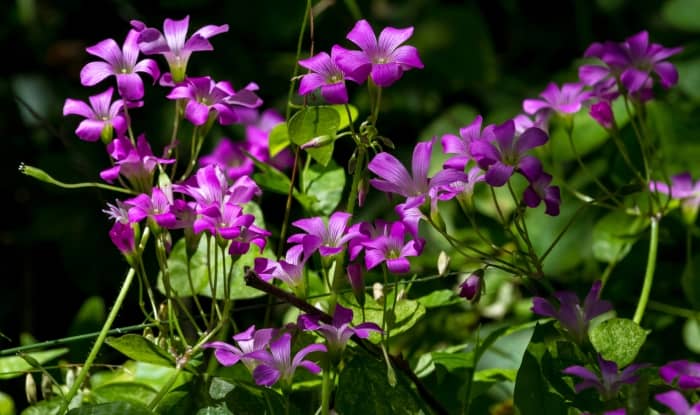
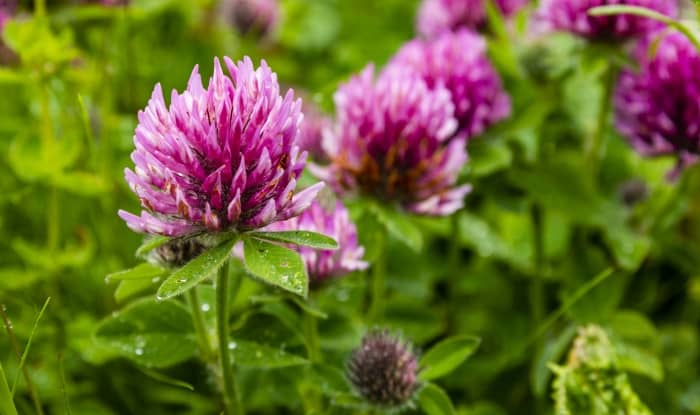
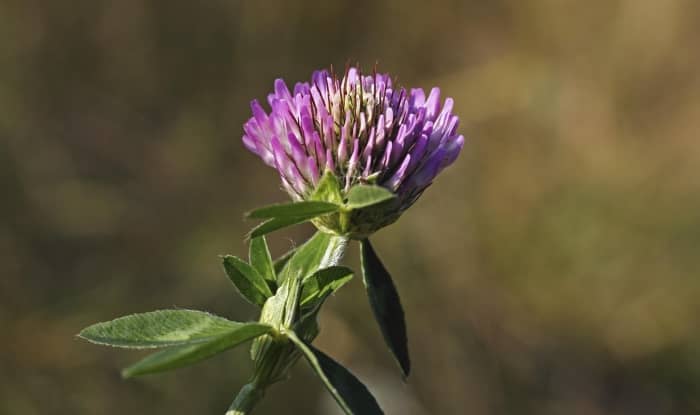
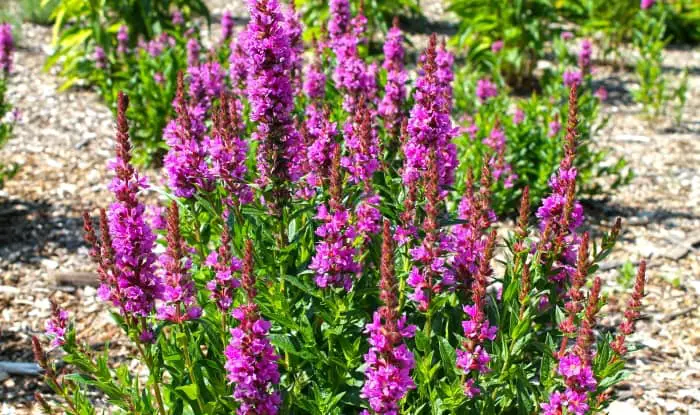
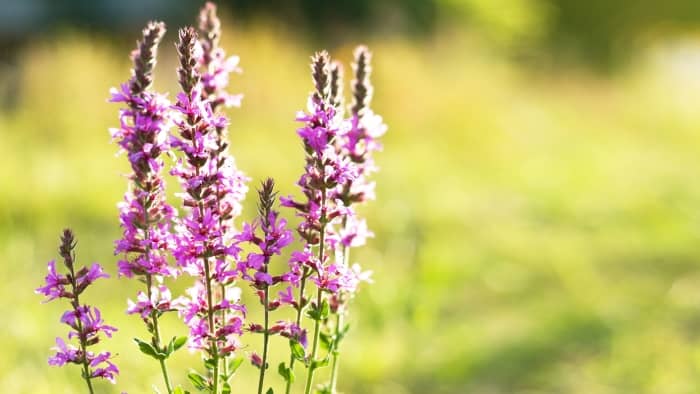


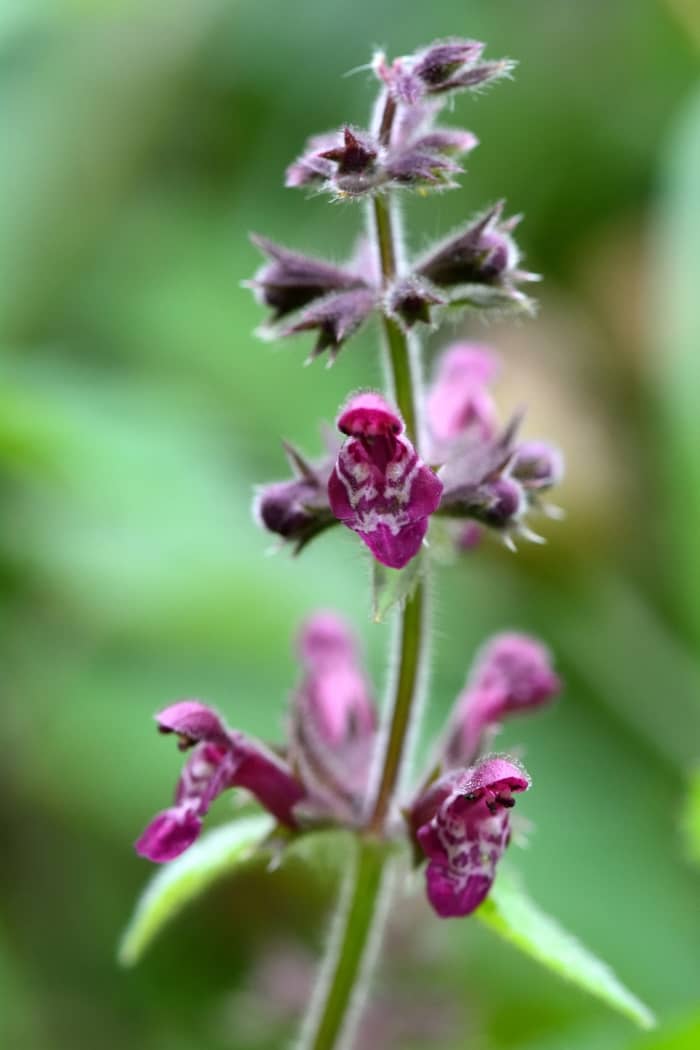
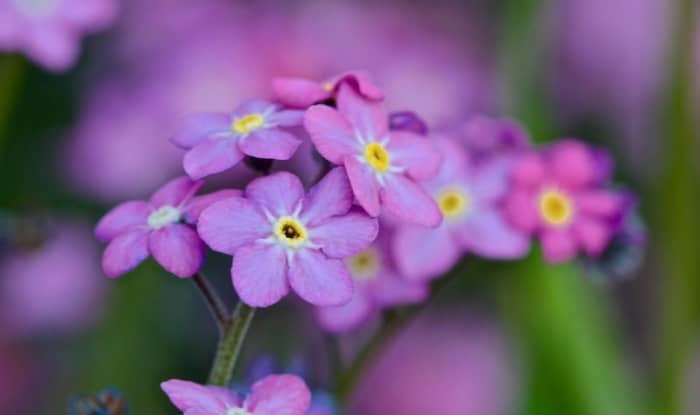

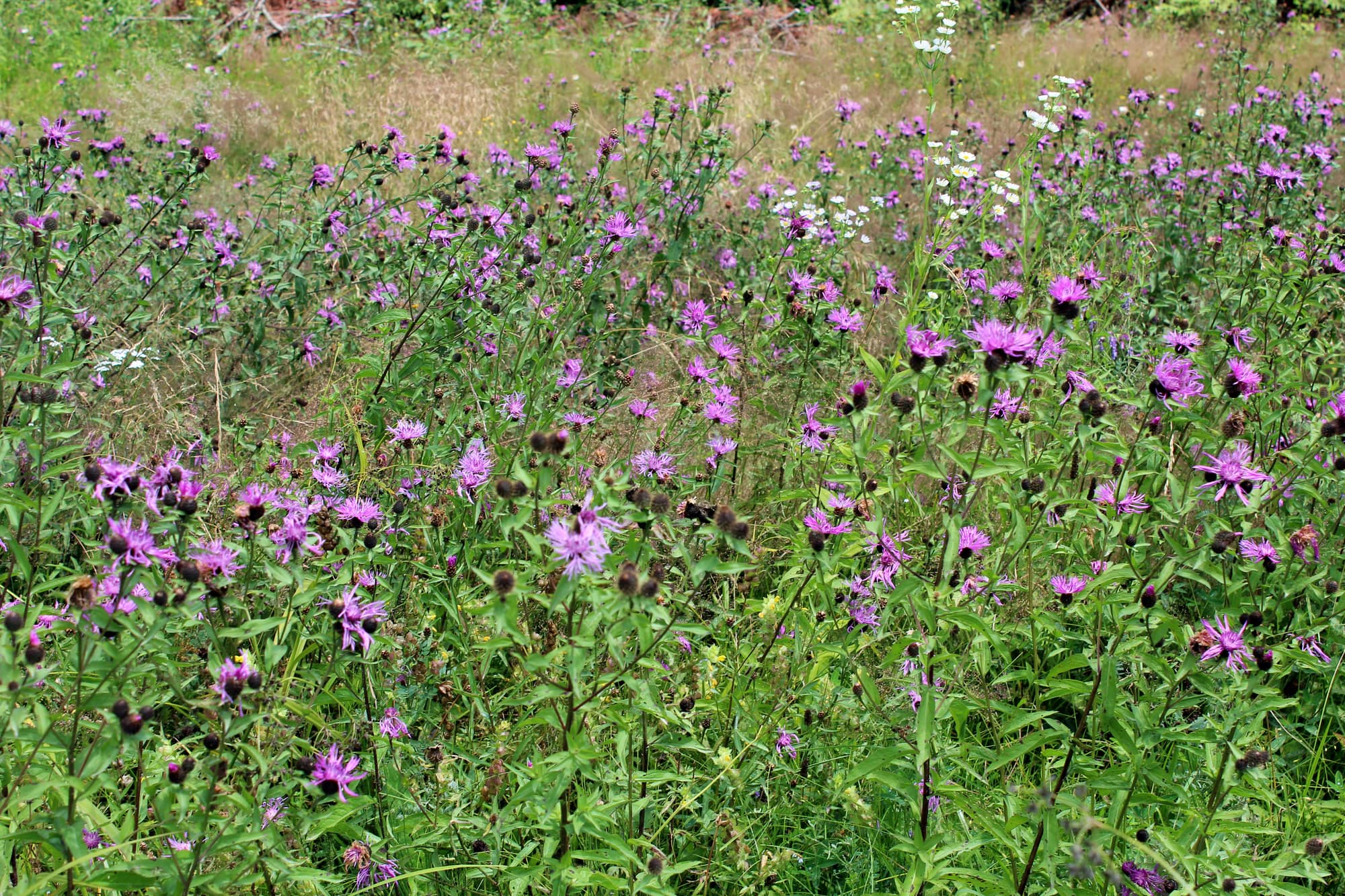
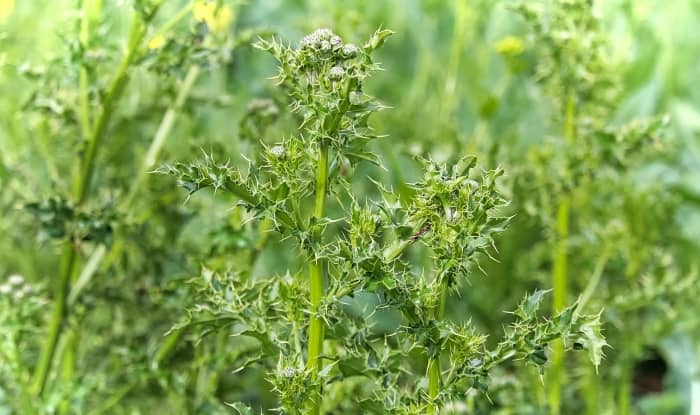
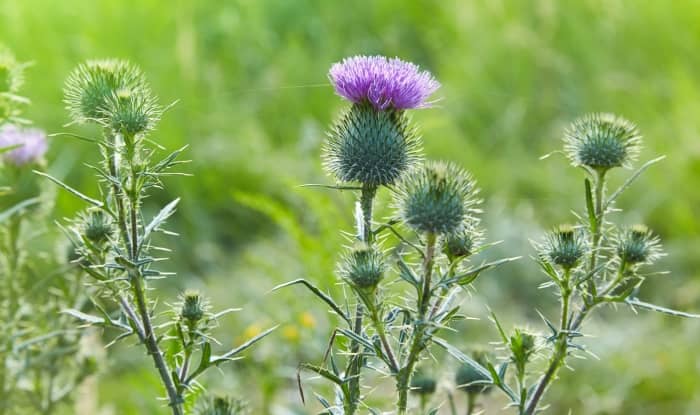
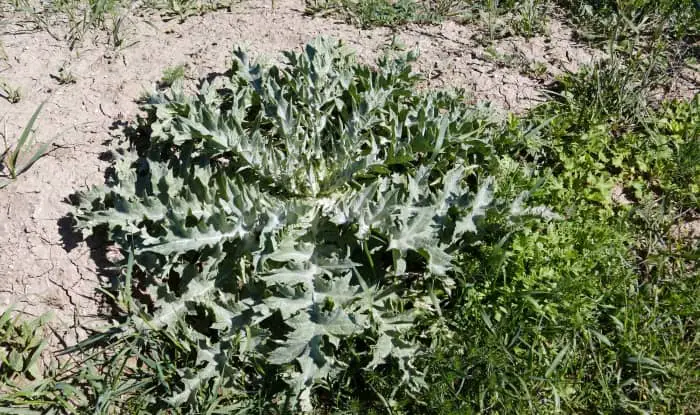



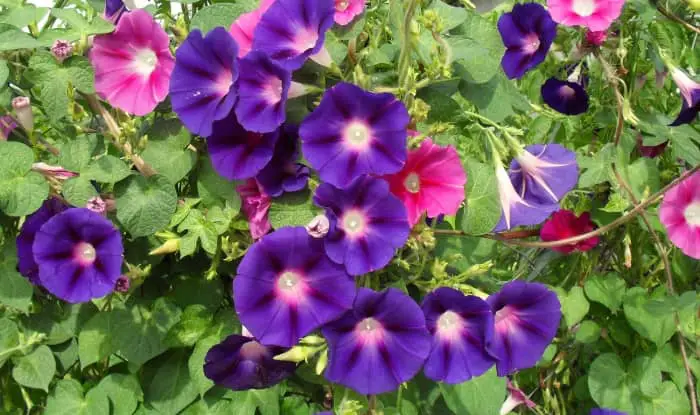
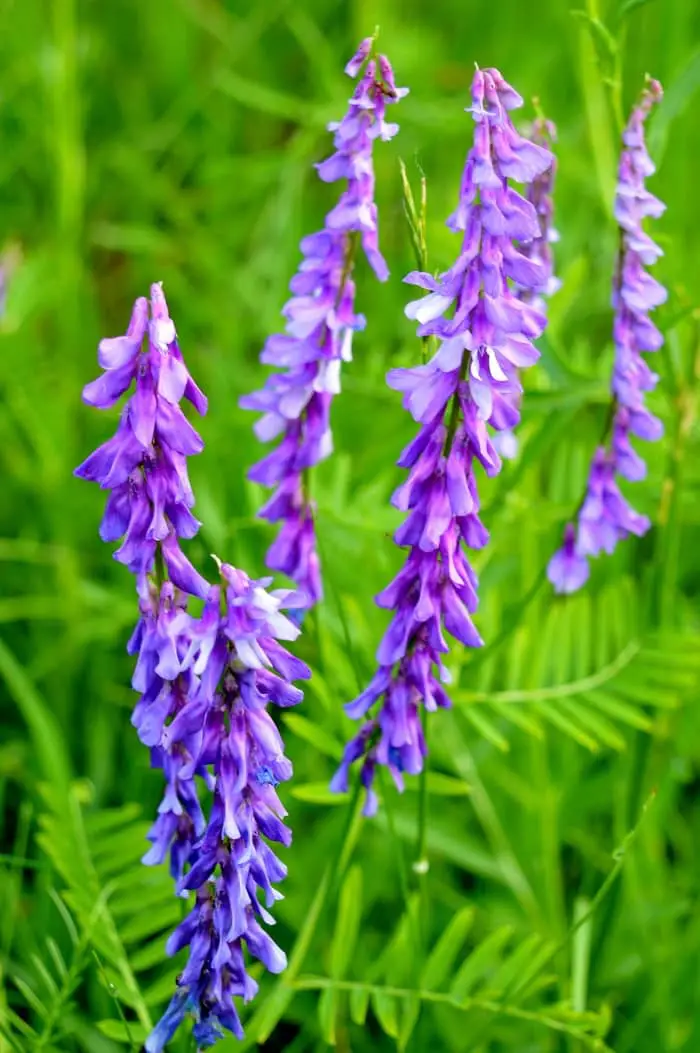

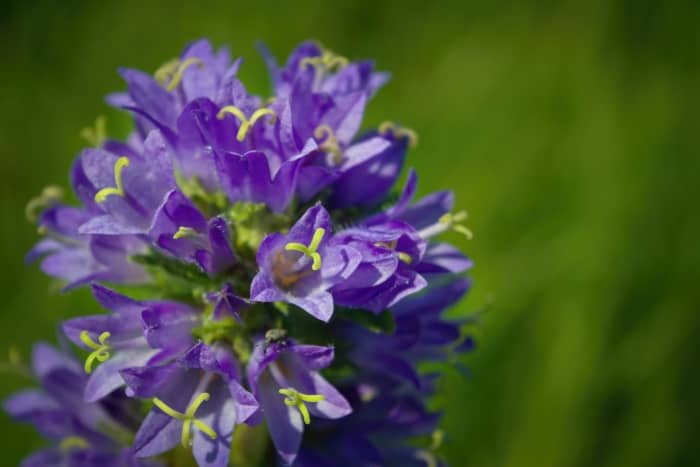
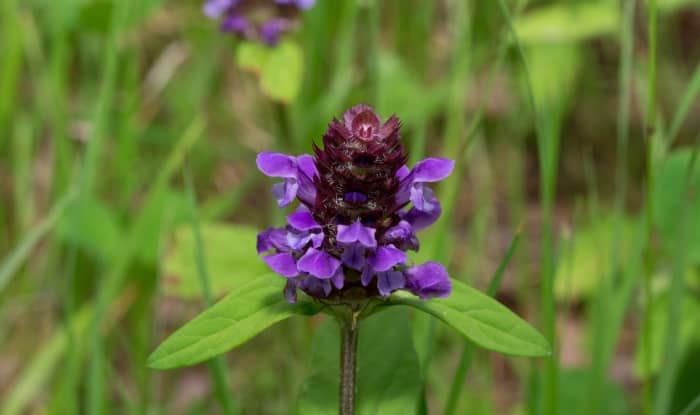
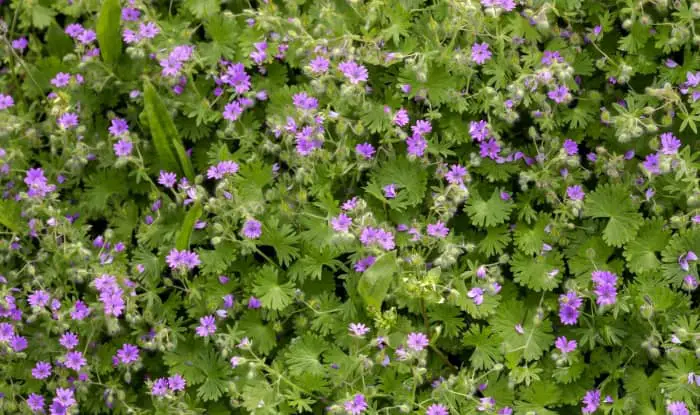
thank you gave me somethings to look for